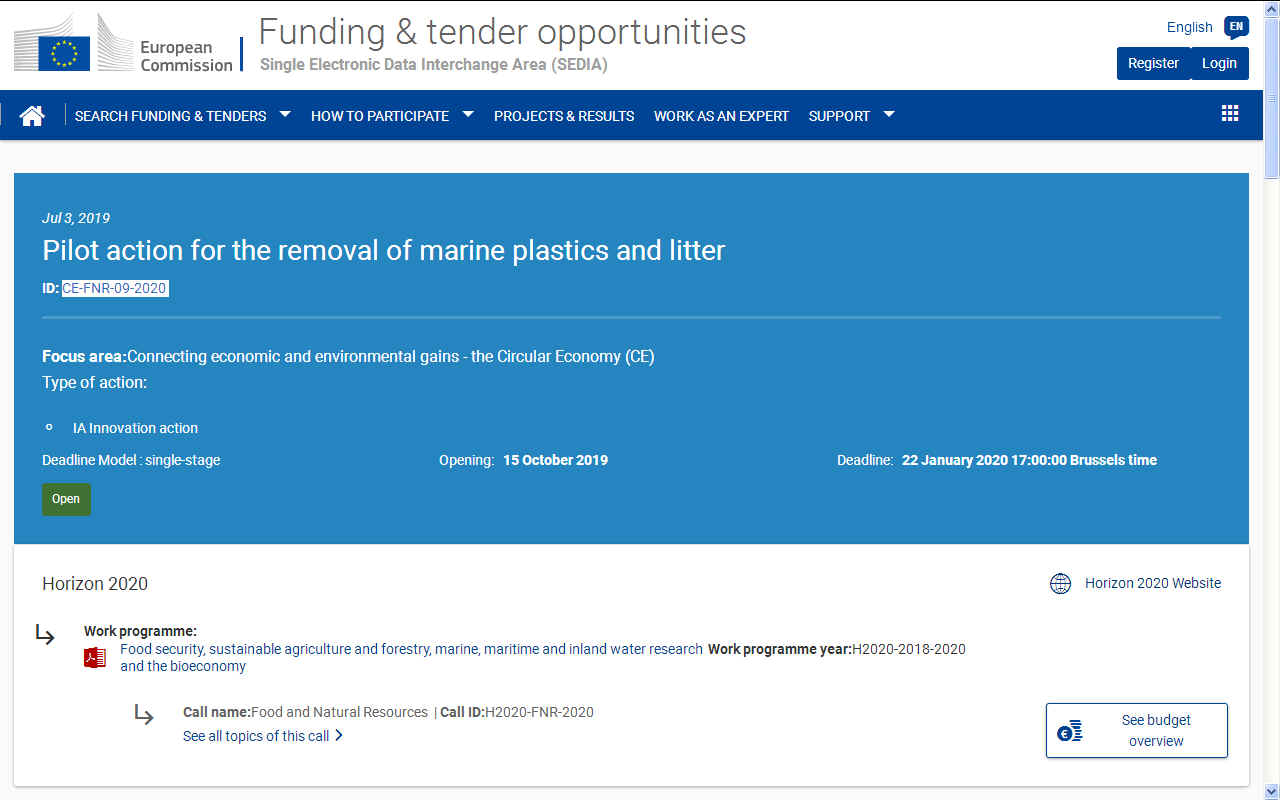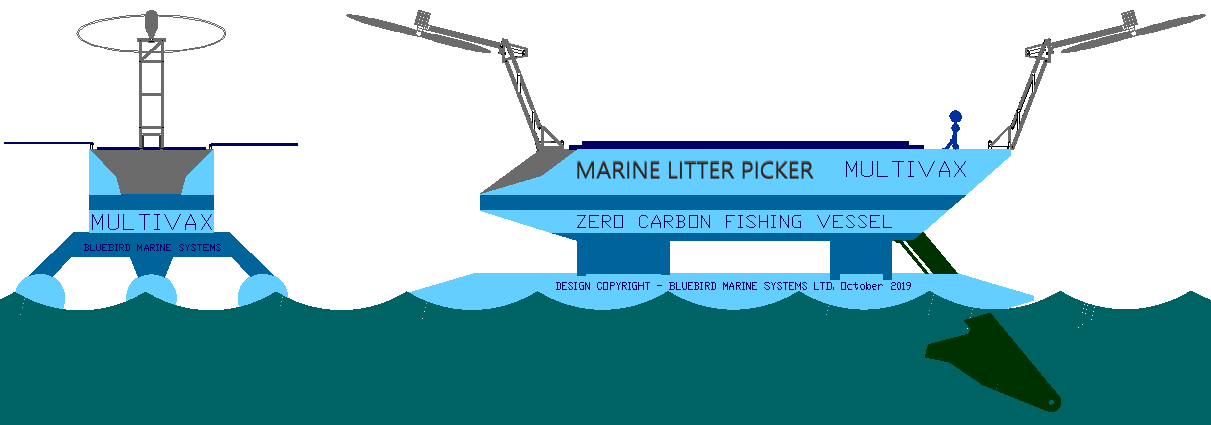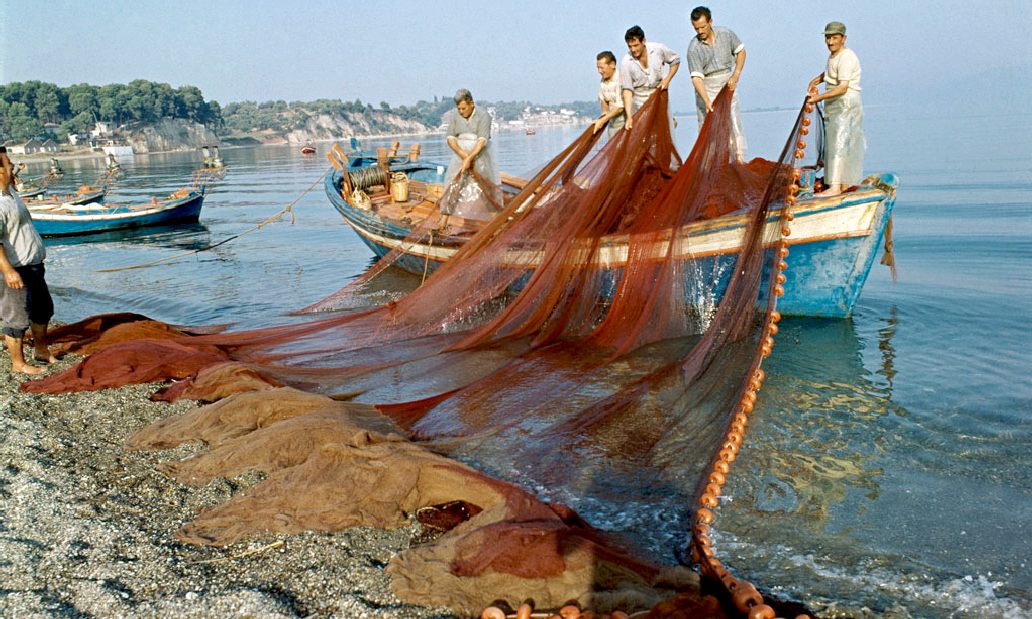|
H2020 CE-FNR-09-2020 MARINE PLASTIC LITTER PILOT ACTION
ABOUT - CLIMATE CHANGE A-Z - CONTACTS - CROWDFUNDING - DONATE - FOUNDATION - HOME - OCEAN PLASTIC A-Z Please use our A-Z INDEX to navigate this site
H2020 WORK PROGRAMME - Pilot action for the removal of marine plastics and litter.
The Horizon 2020 budget for this call is: €13 200 000 Euros looking for proposals in the € 6m region. The deadline for lodging proposals is January 22 2020, Brussels time.
Specific Challenge:
Therefore, urgent action is needed both for the prevention and for the removal of existing marine litter, notably plastics and microplastics. For this topic, a demonstration of the removal of marine litter and research is being proposed, highlighting how the environment is impacted by the removal, and the corresponding impacts in terms of ecosystem and economic recovery.
PILOT MARINE LITTER PICKER - A 16 meter vessel is seen here with the cleaning head deployed to a depth of over 2.5 meters. This would be for inshore and river cleaning duties. Mostly, marine litter is in the top 3 meters of water column, with the bulk of plastic just below the surface less than a meter.
A MultiVax can be configured to operate forwards or backwards - as may the underwater head - meaning that it is bi-directional to add to the versatility of the workboat as an ocean cleaning tool. The payload of this boat is 10 tons or ten cubic meters. The cleaning head may be lifted clear of the water for transit. Twin wind turbines are seen here in the raised position, but furled. The masts may be lowered and operated at different heights to avoid (as much as possible) interference. These are important features of the design. By contrast, a full size SeaVax has a holding capacity of 150 m3.
Scope:
Accompanying research will have to address impacts on coastal ecosystems’ food chains, biodiversity and functioning, fisheries, aquaculture, Marine Protected Areas, wild life and local economies (all of these) 6, 12, 18 and 24 months after the (start of the) cleaning. At the end of the project, the consortium is expected to identify a way forward and lay the foundations for upscaling with a view to a future potentially automated removal of historically accumulated marine litter (legacy), in particular at hot-spots of accumulated marine litter.
The inclusion of actions to reduce other pollutants and effects of stressors is an advantage.
Projects shall demonstrate the effectiveness of an (or several) automatic or remotely controlled wireless device(s) capable of collecting plastics and other marine litter of reasonable size (larger micro-litter and macro-litter up to a meter or so).
The proposed solution must be able to work at the sea surface and on the seafloor/beach. The demonstration has to be for longer periods of time (several months on one site; several sites at the same time are acceptable). The marine litter must be sorted and reused (project must include demonstration of feeding of litter into reuse/recycling chains) in line with the circular economy and the plastics strategy.
The environmental impact, notably on biota, has to be minimized and assessed.
The project must include demonstrations in different sites, including beaches, harbours and shallow seafloor.
This topic is in support of the European Strategy for Plastics in a Circular Economy. Selected projects under this topic as well as projects selected under other topics in H2020 supporting the Plastics Strategy are strongly encouraged to participate in joint activities as appropriate.
These joint activities could take the form of clustering of projects, participation in workshops, common exploitation and dissemination etc. The projects should describe how they will be complementary with already existing relevant national activities or other multilateral activities funded by the EU or funded jointly by several Member States.
The proposals are expected to demonstrate support to common coordination and dissemination activities. Therefore, the proposals should foresee a dedicated work package for this purpose and earmark appropriate resources. Further details of these coordination activities will be defined during the grant preparation phase with the Commission.
The Commission considers that proposals requesting a contribution from the EU in the range of EUR 6 million would allow this challenge to be addressed appropriately. This does not preclude the submission and selection of proposals requesting other amounts.
Expected Impact:
Contributing to the ongoing implementation of EU Policies such as the EU Bioeconomy Strategy, the Circular Economy Strategy, the European Strategy for Plastics in a Circular Economy, the European Integrated Maritime Policy, the Marine Strategy Framework Directive and the UN Sustainable Development Goals, activities will:
In the short-term:
- Support the implementation of the UN Nations Decade of Ocean Science for Sustainable Development, and the needs of the Marine Strategy Framework Directive.
- Achieve at least TRL 6.
- Achieve a removal of 90% of macro-plastic litter and a substantial fraction of micro-litter in the demonstration areas reducing the clean-up cost to the local blue economy.
- Increase availability of efficient and environmentally sustainable technologies to remove existing marine litter.
- Contribute to awareness rising of citizens about the importance of prevention to avoid environmental damage and high costs (for the community and the tax payer instead of the polluter).
- Contribute to the sustainable management and protection of marine and coastal ecosystems to avoid significant adverse impacts (UN SDG 14).
In the medium-term:
- Obtain no more damage from marine litter to the local blue-economy and marine ecosystems services.
- Achieve 80% reduction of micro-plastics in shellfish in treated areas (or other locally important small marine animals).
Increase scientific knowledge, develop research capacity and transfer marine technology, taking into account the Intergovernmental Oceanographic Commission Criteria and Guidelines on the Transfer of Marine Technology, in order to improve ocean health (UN SDG 14).
- Ensure that collected marine plastics are reused or reconverted in a way that is in line with the European Strategy for Plastics in a Circular Economy.
- Shorten the time span between research and innovation and foster economic value in the blue economy.
- Improve the professional skills and competences of those working and being trained to work within the blue economy and in the context of open data sharing.
- Increase data sharing and increase integration of data.
- Contribute to determining the distribution and fate of marine litter and microplastics.
In the long-term:
- Achieve 80% reduction of micro-plastics and plastics in non-migratory birds species in the areas where cleaning technologies are being used.
-
Achieve substantial reduction of micro-plastics originating from macro-plastics locally.
OCEAN & RIVER CLEANER - This vessel is designed to operate in fleets to target ocean waste before it settles on the ocean floor where nobody can recover it economically. There is nothing like it in existence today.
1. Eligible countries: described in Annex A of the Work Programme.
A number of non-EU/non-Associated Countries that are not automatically eligible for funding have made specific provisions for making funding available for their participants in Horizon 2020 projects. See the information in the
Online
Manual.
3. Evaluation:
- Submission and evaluation processes are described in the Online Manual.
4. Indicative time for evaluation and grant agreements:
5. Proposal templates, evaluation forms and model grant agreements (MGA):
6. Additional provisions:
7. Open access must be granted to all scientific publications resulting from Horizon 2020 actions.
The Open Research Data Pilot has been extended to cover all Horizon 2020 topics for which the submission is opened on 26 July 2016 or later. Projects funded under this topic will therefore by default provide open access to the research data they generate, except if they decide to opt-out under the conditions described in
Annex L of the Work
Programme. Projects can opt-out at any stage, that is both before and after the grant signature.
8. Additional documents:
37 ORGANIZATIONS ARE LOOKING FOR COLLABORATION PARTNERS FOR THIS TOPIC
.....
Type of Action: Innovation action [IA]
GET SUPPORT
Please read carefully all provisions below before the preparation of your application.
H2020 Online Manualis your guide on the procedures from proposal submission to managing your grant.
Funding and tenders Portal FAQ – Submission of proposals.
National Contact Points (NCP) - contact your NCP for further assistance in your national language(s).
Research Enquiry Service – ask questions about any aspect of European research in general and the EU Research Framework Programmes in particular.
Enterprise Europe Network– contact your EEN national contact for advice to businesses with special focus on SMEs. The support includes guidance on the EU research funding.
IT Helpdesk Contact the Participant Portal IT helpdesk for questions such as forgotten passwords, access rights and roles, technical aspects of submission of proposals, etc.
Ethics – for compliance with ethical issues, see the Online Manual and Science and Society Portal
Ethics – for compliance with ethical issues, see the Online Manual and Science and Society Portal
Partner Search Services help you find a partner organisation for your proposal.
CALL INFORMATION
FUNDING RATE INNOVATION ACTIONS (IA)
D. Types of action: specific provisions and funding rates1,2
A ‘demonstration or pilot’ aims to validate the technical and economic viability of a new or improved technology, product, process, service or solution in an operational (or near to operational) environment, whether industrial or otherwise, involving where appropriate a larger scale prototype or demonstrator.
A ‘market replication’ aims to support the first application/deployment in the market of an innovation that has already been demonstrated but not yet applied/deployed in the market due to market failures/barriers to uptake. 'Market replication' does not cover multiple applications in the market of an innovation3 that has already been applied successfully once in the market. ‘First’ means new at least to Europe or new at least to the application sector in question. Often such projects involve a validation of technical and economic performance at system level in real life operating conditions provided by the market.
Projects may include limited research and development activities.
Funding rate: 70% (except for non-profit legal entities, where a rate of 100% applies)
CONTACTS
....
LINKS & REFERENCE
https://ec.europa.eu/info/funding-tenders/opportunities/portal/screen/opportunities/topic-details/ce-fnr-09-2020 https://een.ec.europa.eu/partners/h2020-ce-fnr-09-2020-technological-providers-removal-marine-plastic-and-litter-sought https://ec.europa.eu/
SUSTAINABLE FISHING: UN picture of fishermen in Evia, Greece, fishing using nets from small boats as they have for hundreds of years without destroying our fisheries. Marine capture fisheries are a critical component for food security. Their production is close to the maximum ecosystem productivity (NRC 2006), cannot be increased substantially in the future and could decline if not properly managed, leaving the world to solve a significant new food deficit. Micro plastic pollution from rivers is a threat to sustainable production.
This website is provided on a free basis as a public information service. copyright © Cleaner Oceans Foundation Ltd (COFL) (Company No: 4674774) 2019. Solar Studios, BN271RF, United Kingdom. COFL is a charity without share capital. The names AmphiMax™, RiverVax™ and SeaVax™ are trade names used under license by COF in connection with their 'Feed The World' ocean cleaning sustainability campaign.
|



